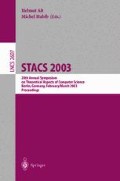Abstract
Via competing provers, we show that if a language A is selfreducible and has polynomial-size circuits then SA 2 = S2. Building on this, we strengthen the Kämper-AFK Theorem, namely, we prove that if NP ⊆ (NP ∩coNP)/poly then the polynomial hierarchy collapses to SNP∩coNP 2 . We also strengthen Yap’s Theorem, namely, we prove that if NP ⊆ coNP/poly then the polynomial hierarchy collapses to SNP 2 . Under the same assumptions, the best previously known collapses were to ZPPNP and ZPPNP NP respectively ([20],[6], building on [18,1,17,30]). It is known that S2 ⊆ ZPPNP [8]. That result and its relativized version show that our new collapses indeed improve the previously known results. Since the Kämper-AFK Theorem and Yap’s Theorem are used in the literature as bridges in a variety of results-ranging from the study of unique solutions to issues of approximation-our results implicitly strengthen all those results.
Supported in part by NIH grants RO1-AG18231 and P30-AG18254, and NSF grants CCR-9322513, INT-9726724, CCR-9701911, INT-9815095, DUE-9980943, EIA-0080124, CCR-0196197, and EIA-0205061.
Access this chapter
Tax calculation will be finalised at checkout
Purchases are for personal use only
Preview
Unable to display preview. Download preview PDF.
References
M. Abadi, J. Feigenbaum, and J. Kilian. On hiding information from an oracle. Journal of Computer and System Sciences, 39:21–50, 1989.
V. Arvind, Y. Han, L. Hemachandra, J. Köbler, A. Lozano, M. Mundhenk, M. Ogiwara, U. Schöning, R. Silvestri, and T. Thierauf. Reductions to sets of low information content. In K. Ambos-Spies, S. Homer, and U. Schöning, editors, Complexity Theory, pages 1–45. Cambridge University Press, 1993.
J. Balcázar, R. Book, and U. Schöning. The polynomial-time hierarchy and sparse oracles. Journal of the ACM, 33(3):603–617, 1986.
J. Balcázar, J. Díaz, and J. Gabarró. Structural Complexity I. EATCS Texts in Theoretical Computer Science. Springer-Verlag, 2nd edition, 1995.
J. Balcázar and U. Schöning. Logarithmic advice classes. Theoretical Computer Science, 99(2):279–290, 1992.
N. Bshouty, R. Cleve, S. Kannan, R. Gavaldä, and C. Tamon. Oracles and queries that are sufficient for exact learning. In Proceedings of the 17th ACM Conference on Computational Learning Theory, pages 130–139, 1994. JCSS 52(3):421–433 (1996).
H. Buhrman and L. Fortnow, Sept. 2001. Personal communication.
J. Cai. Sp 2 ⊆ ZPPNP. In Proceedings of the 42nd IEEE Symposium on Foundations of Computer Science, pages 620–629. IEEE Computer Society Press, Oct. 2001.
J. Cai, V. Chakaravarthy, L. Hemaspaandra, and M. Ogihara. Some Karp-Liptontype theorems based on S2. Technical Report TR-759, Department of Computer Science, Univ. of Rochester, Rochester, NY, Sept. 2001. Revised, Nov. 2002. Available (as the TR-759 entry) at http://www.cs.rochester.edu/trs/theory-trs.html
R. Canetti. More on BPP and the polynomial-time hierarchy. Information Processing Letters, 57(5):237–241, 1996.
R. Gavaldà and J. Balcázar. Strong and robustly strong polynomial time reducibilities to sparse sets. Theoretical Computer Science, 88(1):1–14, 1991.
J. Hartmanis and L. Hemachandra. Complexity classes without machines: On complete languages for UP. Theoretical Computer Science, 58(1-3):129–142, 1988.
L. Hemaspaandra, S. Jain, and N. Vereshchagin. Banishing robust Turing completeness. International Journal of Foundations of Computer Science, 4(3):245–265, 1993.
L. Hemaspaandra, A. Naik, M. Ogihara, and A. Selman. Computing solutions uniquely collapses the polynomial hierarchy. SIAM Journal on Computing, 25(4):697–708, 1996.
L. Hemaspaandra and M. Ogihara. The Complexity Theory Companion. Springer-Verlag, 2002.
J. Hopcroft. Recent directions in algorithmic research. In Proceedings 5th GI Conference on Theoretical Computer Science, pages 123–134. Springer-Verlag Lecture Notes in Computer Science #104, 1981.
J. Kämper. Non-uniform proof systems: A new framework to describe non-uniform and probabilistic complexity classes. Theoretical Computer Science, 85(2):305–331, 1991.
R. Karp and R. Lipton. Some connections between nonuniform and uniform complexity classes. In Proceedings of the 12th ACM Symposium on Theory of Computing, pages 302–309. ACM Press, Apr. 1980. An extended version has also appeared as: Turing machines that take advice, L’Enseignement Mathématique, 2nd series,28, 1982, pages 191–209.
J. Köbler. On the structure of low sets. In Proceedings of the 10th Structure in Complexity Theory Conference, pages 246–261. IEEE Computer Society Press, June 1995.
J. Köbler and O. Watanabe. New collapse consequences of NP having small circuits. SIAM Journal on Computing, 28(1):311–324, 1998.
T. Long. Strong nondeterministic polynomial-time reducibilities. Theoretical Computer Science, 21:1–25, 1982.
C. Lund, L. Fortnow, H. Karlo., and N. Nisan. Algebraic methods for interactive proof systems. Journal of the ACM, 39(4):859–868, 1992.
A. Russell and R. Sundaram. Symmetric alternation captures BPP. Computational Complexity, 7(2):152–162, 1998.
J. Simon. On Some Central Problems in Computational Complexity. PhD thesis, Cornell University, Ithaca, N.Y., Jan. 1975. Available as Cornell Department of Computer Science Technical Report TR75-224.
S. Toda. PP is as hard as the polynomial hierarchy. SIAM Journal on Computing, 20(5):865–877, 1991.
S. Toda and M. Ogihara. Counting classes are at least as hard as the polynomialtime hierarchy. SIAM Journal on Computing, 21(2):316–328, 1992.
V. Variyam. A note on NP ∩ coNP/poly. Technical Report RS-00-19, BRICS, Aarhus, Denmark, Aug. 2000. Note: The author uses NP ∩ coNP/poly to denote what in the present paper is denoted (NP ∩ coNP)/poly.
V. Variyam. AMexp (NP ∩ coNP)/poly. Manuscript, Oct. 2002.
K. Wagner. The complexity of combinatorial problems with succinct input representations. Acta Informatica, 23(3):325–356, 1986.
C. Yap. Some consequences of non-uniform conditions on uniform classes. Theoretical Computer Science, 26(3):287–300, 1983.
Author information
Authors and Affiliations
Editor information
Editors and Affiliations
Rights and permissions
Copyright information
© 2003 Springer-Verlag Berlin Heidelberg
About this paper
Cite this paper
Cai, JY., Chakaravarthy, V.T., Hemaspaandra, L.A., Ogihara, M. (2003). Competing Provers Yield Improved Karp-Lipton Collapse Results. In: Alt, H., Habib, M. (eds) STACS 2003. STACS 2003. Lecture Notes in Computer Science, vol 2607. Springer, Berlin, Heidelberg. https://doi.org/10.1007/3-540-36494-3_47
Download citation
DOI: https://doi.org/10.1007/3-540-36494-3_47
Published:
Publisher Name: Springer, Berlin, Heidelberg
Print ISBN: 978-3-540-00623-7
Online ISBN: 978-3-540-36494-8
eBook Packages: Springer Book Archive

